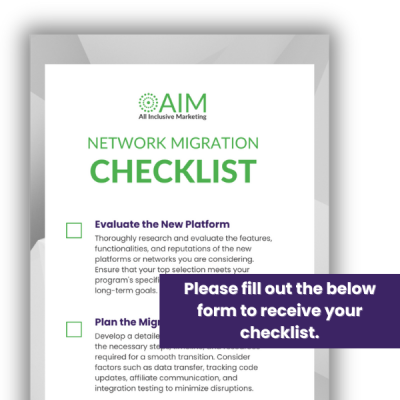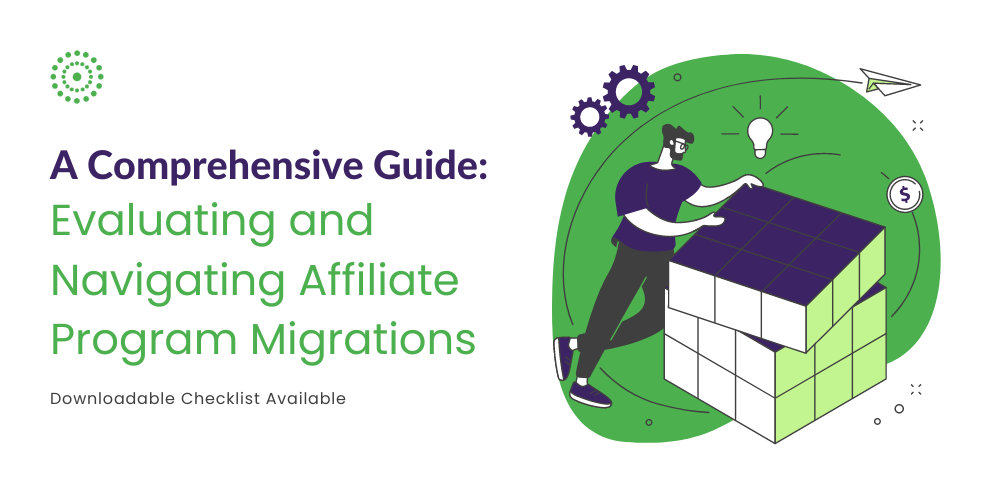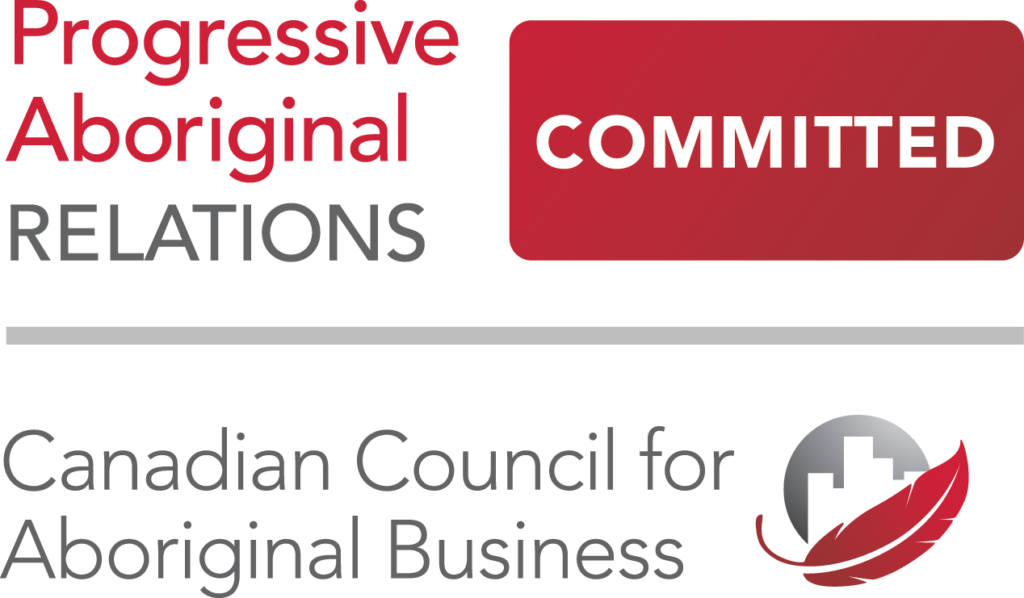An established affiliate program takes a lot of time, effort, and know-how to move from one network or platform to another. So why might you consider migration if things seem fine at a glance?
Migrating an affiliate program can offer opportunities for growth, improved performance, and better management. However, careful planning, effective communication, and ongoing evaluation are crucial to ensure a successful transition. As well as maximize the program’s potential on the new system.
If you’re wondering if a migration is what your program needs, let’s start with the why and how of migration. To begin, here are a few potential reasons it might be worth considering a move:
Why Migrate?
Strategic decisions often prompt businesses to evaluate the performance and potential of their existing affiliate program. Deciding to migrate an established program should not be taken lightly. However, another network can revitalize the program, open doors to new partnerships, and maximize its success. If you find yourself faced with the decision to move, here are some important considerations and steps to follow.
Upgraded Features and Functions: Programs often outgrow the capabilities offered by their first service provider and need room to grow. While the existing affiliate platform may have served as a suitable starting point to test your program’s viability, achieving your program growth goals necessitates a more robust solution.
- Step 1: First, ensure your program is utilizing all of the tools available. Then, review the performance and growth of the program so far. Is the platform meeting your needs now? Will it meet your program needs if the program meets growth goals in the next year or two? Are there limits on how much you can grow?
Refined Affiliate Tools: Moving to a new platform can streamline affiliate management processes, making it easier to manage, support, and acquire new partnerships. This includes efficient communication tools, performance monitoring, attribution methods, partner marketplaces, and payment systems.
- Step 2: Review how your current program communicates with partners, handles payments, and tracks partner performance to identify areas for improvement. Also, consider your program management style and determine what might need to change to become or remain competitive with other programs. What’s missing or could be improved? Does the network you are currently using provide you with the features you want?
Increased Reach and Exposure: Moving to a new platform might allow the program to tap into a larger affiliate base or gain exposure to a new audience. This expanded reach can lead to increased conversions and revenue potential.
- Step 3: Review your current affiliate partner base, and complete an analysis to determine which partner types (or who specifically) you may be missing from your program. Then, look at your competitor’s online affiliate presence. Do they have partners you want to work with that aren’t in your program today? Do you need to expand your program to new geographic locations? Or, into new languages to reach the audience growth you desire? Ask yourself what else might be affecting the publisher base of your program and determine your needs for growth.
Improved Commission Structures: If the current program struggles to attract and retain affiliates due to its commission structure, migrating to a new platform can offer the opportunity to revamp the commission model. A more attractive commission structure can incentivize existing affiliates and attract new ones, ultimately driving better results.
- Step 4: Consider how you are paying commissions today. Do you need to adjust for attribution payouts moving away from only first or last-click attribution? Do you need to revamp your rates based on the action type or partner type to incentivize and boost performance? Are you managing bonus payouts or worse- regular payouts manually, costing you valuable time and increasing the risk of user error? If the answer to any of these questions is yes, it may be time to consider a migration to a service provider that better fits your needs.
Enhanced Tracking and Reporting: Accurate tracking and comprehensive reporting are critical for analyzing affiliate performance and optimizing the program. If the current platform lacks robust tracking capabilities or provides inadequate reporting, it might be time to switch. A new platform may provide more reliable and detailed data, enabling better decision-making and program transparency.
- Step 5: Know where your source of truth (SOT) is and what information you need to correlate between the platform and your SOT. Can you sync your reporting systems with a new platform’s requirements? Is your development team ready now or five months from now to make changes? Are there tracking details you need to update before or when you move to a new platform? Do you need additional or improved compliance features from a new platform? Have your questions ready when you begin speaking with alternative service providers to ensure a seamless migration to the new platform.
What is Involved with a Migration?
Technical Transition: Migrating an affiliate program involves transferring all relevant data, including affiliate accounts, tracking codes, and program settings, from the existing platform to the new one. This process requires careful planning and execution to ensure a smooth transition without disruptions to tracking or payments.
- Note: This is also the moment to make crucial updates to key program settings, such as updating commission structures and attribution models and adjusting reporting KPI features within tracking set-ups.
Affiliate Communication: During the migration, it is crucial to keep affiliates informed about the process. This includes any necessary actions they need to take (e.g. joining a new platform, updating their tracking codes). Clear and timely communication helps maintain trust and minimize any potential confusion or negative impact on affiliates’ performance.
- Note: Not giving your current network the correct notice period in your contract can result in added costs due to being fined. Be aware of your current contract limitations and reach out to AIM if you have any questions about how to best handle a migration.
Learning and Adaptation: Moving to a new platform often requires program managers and affiliates to familiarize themselves with the new system, its interface, and any updated processes. Adequate training and support should be provided to ensure a seamless transition and to help affiliates continue promoting effectively.
- Note: Have a schedule and content calendar in place to educate your existing partners and to reach and motivate newly joined partners.
Performance Evaluation: After the migration, it is essential to closely monitor the program’s performance to identify any issues or areas for improvement. Tracking metrics such as affiliate sign-ups, conversions, revenue, compliance, and overall program growth can help gauge the success of the migration and inform future strategies.
- Note: Ensure you have a strong growth strategy in place when you migrate your program. Migrations take time (technical integration and testing periods are imperative to success) and the ramp-up period after launching on a new system can vary from program to program.
Additionally, it is not uncommon to run a program on two different networks or to have an overlap of services as you migrate a program from one network to another. There are a number of ways you can update your program while making transitional movements for your business and affiliates. Reach out to AIM to learn about your options.
Is It Time to Migrate?
In conclusion, migrating an affiliate program can present valuable opportunities, but is it the right step for your program? By weighing the potential advantages against the necessary considerations, you can make an informed decision that positions your program for growth, success, and thriving partnerships.
By utilizing the helpful guidance and recommendations provided above, you will be able to confidently evaluate the possibility of migrating your program. However, it’s crucial to acknowledge that program migration is a complex process that demands careful attention and diligence. We recognize that knowing where and how to initiate the migration can be challenging. That’s why we have developed a user-friendly program migration checklist for you to follow. Download your copy today and take the first steps toward a seamless and successful migration.













